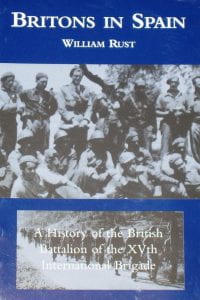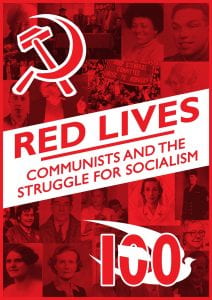I have just finished a trio of books which are simply outstanding, they are the most inspiring books I have read for some time.
 Britons in Spain by William Rust is the history of the British Battalion written by Wiliam Rust, a Communist functionary who edited the party newspaper, The Daily Worker. Originally published by the Communists’ own publishing house, Lawrence & Wishart in 1938, it was written while the war wasin it’s last stages. It traces the history of the British Battalion and includes a Roll of Honour. The journalistic style made this a pleasure to read, and with the first hand accounts, usually focussed upon the interactions between the men, it gave me a fresh insight into the Battalion.
Britons in Spain by William Rust is the history of the British Battalion written by Wiliam Rust, a Communist functionary who edited the party newspaper, The Daily Worker. Originally published by the Communists’ own publishing house, Lawrence & Wishart in 1938, it was written while the war wasin it’s last stages. It traces the history of the British Battalion and includes a Roll of Honour. The journalistic style made this a pleasure to read, and with the first hand accounts, usually focussed upon the interactions between the men, it gave me a fresh insight into the Battalion.
 Red lives a compilation of biographies of Communist activists was published to mark The Communist Party centenary. It gives a brief account of the lives of remarkable men and women, young, veteran black and white activists who displayed a brave and thoughtful contribution to the struggle for socialism over the last hundred years; some fought in Spain, entered South Africa clandestinely, organised in the Scottish coalfields, led housing campaigns in the Midlands and fought racism in the Cardiff docks. Many went to prison for their beliefs.
Red lives a compilation of biographies of Communist activists was published to mark The Communist Party centenary. It gives a brief account of the lives of remarkable men and women, young, veteran black and white activists who displayed a brave and thoughtful contribution to the struggle for socialism over the last hundred years; some fought in Spain, entered South Africa clandestinely, organised in the Scottish coalfields, led housing campaigns in the Midlands and fought racism in the Cardiff docks. Many went to prison for their beliefs.
It’s a collective story of sacrifice, demonstrating an unrivalled contribution to building solidarity with labour movements and work with the oppressed at home and abroad. One story tells us that in the occupied Channel Islands, whilst the Communist Party was being repressed on the mainland, party members formed the main resistance to the Nazis. Further highlights are the stories of the significant number of members, in Spain as volunteers and in the armed forces who paid with their lives. Many of the stories are heartbreaking, demonstrating the sustained persecution of activists, however the thrust of the publication is positive. The added bonus is finding the stories of familiar and unfamiliar men and women who inspire, this is a magnificent record and memorial.
Firing a Shot for Freedom by Frida Stewart
 The finest of the three is certainly Firing a Shot for Freedom, although some of her life story was published during the Second World War, this is the first publication of Frida Stewart’s story in full; from her birth in 1910 through to her work on the manuscript of this book in the years before her death in 1996. I do feel that the years after the Second World War are described too briefly however.
The finest of the three is certainly Firing a Shot for Freedom, although some of her life story was published during the Second World War, this is the first publication of Frida Stewart’s story in full; from her birth in 1910 through to her work on the manuscript of this book in the years before her death in 1996. I do feel that the years after the Second World War are described too briefly however.
This is Frida’s account, with Angela Jackson writing a loving foreword and afterword, it is apparent that for Angela Jackson this was a labour of love, it is certainly an outstanding tribute to a very special woman.
Frida begins with an account of her privileged childhood, her parents Hugh was a ‘don’ at Trinity College Cambridge and Jessie, who is described as a ‘university wife’ is clearly an activist, for we have Frida’s opening account of Jessie raising money for Belgian refugees during The Great War. There are fascinating insights into education at a Dame School in Newnham, where Frida recollects seeing ‘bedraggled German PoWs labouring’. Frida’s description of Cambridge in the 20s and 30s is remarkably vivid, but it is her love of music that binds the narrative, highlighting her enthusiasm, compassion and love.
Frida gives us a fresh insight into the 1926 General Strike by describing how it affected the idyllic life in Cambridge. The first link to my research comes when she talks about the Hunger Marches, for the Stockton contingent passed through Cambridge in 1932 and 1934. Frida drove ambulances to Spain during the Spanish Civil war and was involved with her mother in the care of 29 Basque children at hostels first in Pampisford and then in Station Road, Cambridge. This brought a myriad of links, not only to the British Battalion and the prominent figures in the Aid to Spain campaign, but to the very people I am currently researching.
Frida worked with the Pennymans of Ormesby Hall as part of the team planning and organising their response to Unemployment in East Cleveland in the early 1930s; sharing her love of music with ‘Red’ Ruth and Michael Tippett. Frida returned to work with Jim and Ruth Pennyman when Ruth accommodated Basque refugees at Hutton Hall, travelling with four of Ruth’s refugee’s to Switzerland in 1938. Frida was a significant activist in the campaign to care for Spanish refugees and Aid to Spain.
Frida’s compassion and commitment is graphically illustrated as she tries to assist and care for the Spanish refugees who fled Franco to internment camps in France. She was in France when the Nazis invaded and found herself in turn interned, her daring-do escape from the Nazi internment camp reads like the finest thriller; enhanced by her vivid recollections of Nazi occupied Europe. Ironically for an anti-fascist, Frida escaped back to the UK via Franco’s Spain, which is described in the penultimate chapter.
As said earlier the following fifty years of Frida’s life is covered in one short chapter by Frida and Angela’s afterword. I found this initially frustrating, because Frida’s narrative was so engaging and positive I did not wish it to stop. I think that Angela should be praised for the decision to briefly sketch the last two thirds of Frida’s life, for this has allowed the publication to retain Frida’s voice, this is Frida’s story, told by Frida; it is what she wanted to tell people.
One last note; it was Mike Wild who recommended Firing a shot for freedom to me, and recommending the publisher. Like this book, I highly recommend The Clapton Press Simon Deefholts, the Managing Director, provided an outstanding and personal service, emailing to inform me that the book was in transit, and responding to questions, I will certainly be purchasing from him again.


Wonderful stuff.